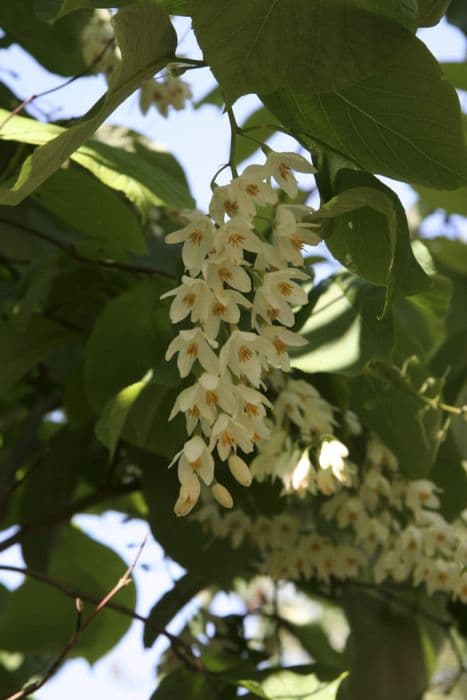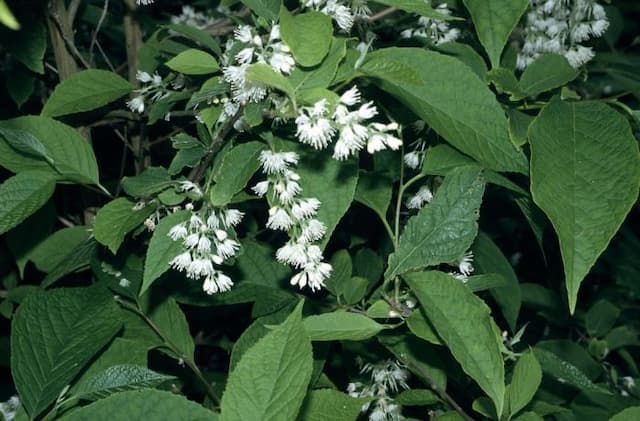Chinese Storax Styrax hemsleyanus

ABOUT
Styrax hemsleyanus, commonly known as the snowbell tree, is a visually appealing plant characterized by its aesthetically pleasing form and delicate features. The primary attraction of this tree is its profusion of floral ornaments that often emerge in spring or early summer. When in bloom, the snowbell tree displays an abundance of bell-shaped flowers that dangle gracefully from its branches, resembling dainty white or pale pink snowbells. These flowers exude a subtle yet enchanting fragrance that contributes to the sensory delight of the plant. The foliage of the snowbell tree consists of bright green leaves that have a smooth, glossy surface and typically sport an oval to oblong shape. The edges of the leaves are finely toothed, which adds a touch of refinement to the overall lushness of the plant's canopy. During the autumn season, the leaves may transform to exhibit a range of warm tones, which enhances the visual interest of the snowbell tree as the seasons shift. Following the flowering period, the plant may produce small fruit that adds to its ornamental value. The fruits are generally round or ovoid, offering a subtle textural contrast to the smooth leaves. Overall, the snowbell tree is recognized for its elegant structure and the cascading effect of its blooms, which contribute to the charm of gardens, parks, or landscapes where it is planted. Its delicate yet robust appearance allows it to blend seamlessly into various settings, from the understated elegance of a formal garden to the wilderness of a natural wooded area.
About this plant
 Names
NamesFamily
Styracaceae
Synonyms
Hemsley's Snowbell
Common names
Styrax hemsleyanus.
 Toxicity
ToxicityTo humans
There is limited information available on the toxicity of the Chinese snowbell (Styrax hemsleyanus) to humans. As of my last update, it is not widely recognized as a poisonous plant to humans. However, like with any plant, sensitivity varies among individuals, and some people might experience mild irritation or allergic reactions when handling or ingesting plants that are not typically considered toxic. It is always advisable to exercise caution and avoid eating or extensively handling parts of ornamental plants due to the potential for unknown or idiosyncratic reactions. If you suspect poisoning from any plant, seek medical attention promptly.
To pets
Similar to the information available for humans, there is limited specific data on the toxicity of the Chinese snowbell (Styrax hemsleyanus) to pets. It is not commonly listed among plants that are poisonous to pets such as cats and dogs. Nevertheless, individual animals might have sensitivities or allergies that could result in mild to moderate symptoms if they ingest parts of the plant. Symptoms could include gastrointestinal upset, such as vomiting or diarrhea. As a general precaution, it is sensible to prevent pets from ingesting ornamental plants. If you believe your pet is suffering from poisoning after ingesting any part of this or another plant, contact a veterinarian immediately.
 Characteristics
CharacteristicsLife cycle
Perennials
Foliage type
Deciduous
Color of leaves
Green
Flower color
White
Height
15 feet (4.57 meters)
Spread
10 feet (3.04 meters)
Plant type
Tree
Hardiness zones
7
Native area
China
Benefits
 General Benefits
General Benefits- Aesthetic appeal: Styrax hemsleyanus, commonly known as Chinese snowbell, adds beauty to landscapes with its delicate white flowers and attractive foliage.
- Habitat for wildlife: The Chinese snowbell provides shelter and food for various insects and birds, enhancing biodiversity.
- Shade provision: With its broad canopy, the Chinese snowbell offers shade and can help in cooling the surrounding area.
- Soil improvement: The fallen leaves of the plant decompose and enrich the soil with organic matter, thus improving soil quality.
- Erosion control: The root system of the Chinese snowbell can help stabilize the soil and prevent erosion.
- Cultural significance: In some cultures, the Chinese snowbell is valued for its beauty and is incorporated into traditional garden designs.
- Seasonal interest: The plant has a seasonal rhythm that provides visual interest throughout the year, with blossoms in spring and leaf color changes in autumn.
 Medical Properties
Medical Properties- Antimicrobial Activity: Extracts from Styrax hemsleyanus have shown potential antimicrobial properties, effective against certain bacteria and fungi.
- Anti-inflammatory Properties: Components within this plant may have the ability to reduce inflammation.
- Analgesic Effects: It is sometimes used in traditional medicine for its potential analgesic properties to alleviate pain.
- Wound Healing: There is some evidence to suggest that Styrax hemsleyanus may promote wound healing due to its antimicrobial and anti-inflammatory properties.
 Air-purifying Qualities
Air-purifying QualitiesThis plant is not specifically known for air purifying qualities.
 Other Uses
Other Uses- Ornamental landscaping – Styrax hemsleyanus, commonly known as Snowbell tree, is often used in ornamental landscaping for its attractive drooping white flowers and pleasing aesthetic form.
- Perfumery – The oil extracted from the flowers of the Snowbell tree can be used in the manufacturing of perfumes due to its delicate fragrance.
- Aromatherapy – The scented flowers might contribute to essential oils used for aromatherapy practices.
- Beekeeping – As a nectar-producing plant, Snowbell trees can be planted to support beekeeping efforts and to produce unique floral honey.
- Insect repellent – The leaves of the Snowbell tree are sometimes used in natural insect repellent formulations.
- Educational use – This species can be used for botanical studies and educational purposes, showcasing the diversity of the Styrax genus.
- Tannin production – The bark of Styrax hemsleyanus may contain tannins, which can be used in the tanning industry for processing leather.
- Wood crafting – The wood of the Snowbell tree is fine-grained and might be used in the creation of small wooden items or crafts.
- Seasonal decorations – Dried branches with seed pods can be used for creating unique and natural decorative elements in bouquets or wreaths.
- Dye extraction – Plant parts may have the potential to be used as a source of natural dyes for textiles or handicrafts.
Interesting Facts
 Feng Shui
Feng ShuiThe plant_name is not used in Feng Shui practice.
 Zodiac Sign Compitability
Zodiac Sign CompitabilityThe plant_name is not used in astrology practice.
 Plant Symbolism
Plant SymbolismI'm sorry, but as of my last update, there is no widely recognized symbolic meaning for the plant Styrax hemsleyanus, commonly known as Snowbell. This plant is not commonly featured in symbolic or cultural contexts like some other more widely known plants. Therefore, I cannot provide an HTML list of symbolic meanings for it.
 Water
WaterThe Chinese snowbell should be watered deeply but infrequently, allowing the soil to dry out slightly between waterings. A good rule of thumb is to provide about 1 to 2 gallons of water every week during the growing season, depending on weather conditions. In the winter, reduce watering to every other week, or as needed, to maintain moist but not waterlogged soil. Overwatering can lead to root rot, so ensure proper drainage.
 Light
LightThe Chinese snowbell prefers bright, indirect light and can tolerate some partial shade. Ideal placement is in a location where it receives morning sun and is protected from the intense heat of the afternoon sun. It should not be placed in deep shade as this can lead to poor flowering and leggy growth.
 Temperature
TemperatureThe Chinese snowbell does best in temperatures that range between 60°F and 75°F. It can withstand a minimum temperature of around 50°F; however, exposure to temperatures below this can harm the plant. It is important to protect the plant from harsh winter conditions and to avoid placing it in areas with extreme temperature fluctuations.
 Pruning
PruningPruning the Chinese snowbell is mainly for shape and to remove any damaged or diseased branches. It should be pruned in late winter or early spring before new growth begins. Pruning after spring can remove the current year's flowers, so timing is crucial. Thinning the canopy can also help improve air circulation and light penetration.
 Cleaning
CleaningAs needed
 Soil
SoilSnowbell prefers well-draining soil with high organic matter. A mixture of two parts loam, one part peat, and one part perlite or sand creates an ideal growing medium. The pH should be slightly acidic to neutral, ranging from 5.5 to 7.0, to support healthy growth.
 Repotting
RepottingSnowbell usually requires repotting every 2-3 years to refresh the soil. Young plants may need repotting more frequently, annually, to accommodate rapid growth, while mature specimens can be repotted less often.
 Humidity & Misting
Humidity & MistingSnowbell thrives in moderate to high humidity conditions, ideally between 40% and 60%. Avoid placing these plants in overly dry environments, which can stress the plant and affect its growth and flowering.
 Suitable locations
Suitable locationsIndoor
Place Snowbell in bright, indirect light indoors, away from drafts.
Outdoor
Plant Snowbell in partial shade, shelter from strong winds.
Hardiness zone
7-9 USDA
 Life cycle
Life cycleStyrax hemsleyanus, commonly known as Hemsley's Snowbell, begins its life as a seed, which germinates in suitable soil conditions, typically requiring a period of cold stratification to break dormancy. Upon germination, the seedling emerges and develops a root system and a shoot that grows into a young sapling. As it matures, the plant develops a woody stem and a branching pattern, eventually reaching the juvenile stage and forming its distinctive simple, ovate leaves. Flowering typically occurs once the plant reaches maturity, with the Hemsley's Snowbell producing fragrant white flowers that are bell-shaped, usually blooming in spring or early summer. After pollination, often facilitated by insects, the plant develops fruit in the form of a dry capsule containing several seeds which, when mature, are dispersed to give rise to new plants. The Hemsley's Snowbell is a perennial species, thus after flowering and fruiting, it enters a period of dormancy, usually in the winter, before resuming growth in the following season.
 Propogation
PropogationPropogation time
Spring to summer
Propogation: The most popular method of propagating the Styrax hemsleyanus, or Hemsley's Snowbell, is through seed sowing. The best time for sowing seeds is in the fall immediately after harvest, which allows them to undergo natural stratification over the winter. To propagate Hemsley's Snowbell by seed, the collected seeds should be sown in a cold frame as soon as they are ripe. The soil should be kept moist but not waterlogged. Once seedlings are large enough to handle, they should be potted into individual containers and grown on in cooler conditions until they are strong enough to be planted out in their permanent positions. This typically takes at least a couple of years because Styrax hemsleyanus is slow-growing in its juvenile stages.



![Japanese snowbell [Marley's Pink Parasol]](/_next/image?url=https%3A%2F%2Fplants-admin.emdemapps.com%2Fimages%2Fplants%2F%2Fimages%2F604b602fef992.png&w=640&q=75)
